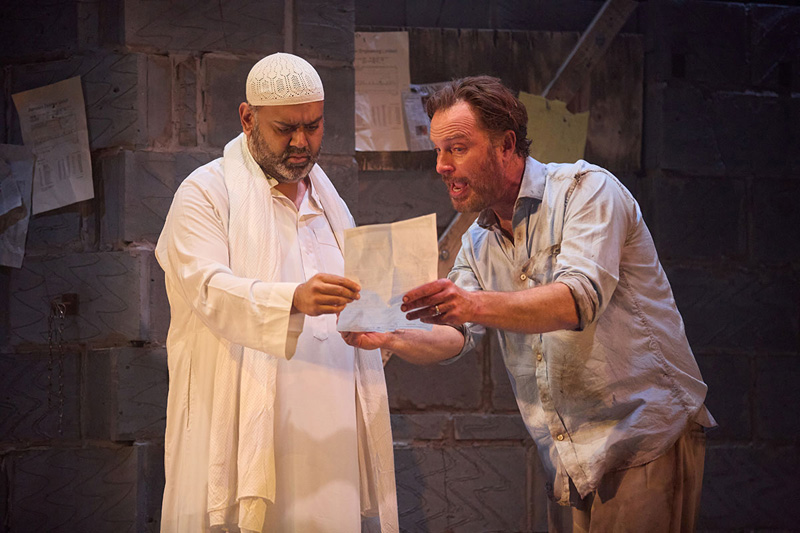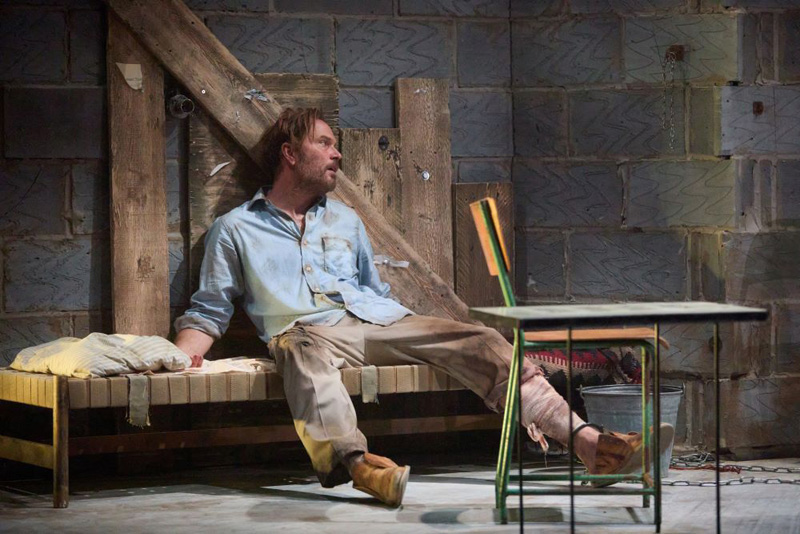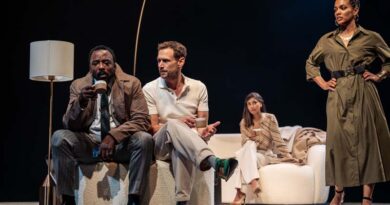“The Two Character Play”: Hampstead Theatre
Jef Hall-Flavin in north London
27 July 2021
If The Two Character Play is one of Tennessee Williams’s problematic plays, director Sam Yates can consider the problem solved. In the interest of full disclosure, I write from the vantage point of having directed a Tennessee Williams festival for 13 years, during which time I’ve seen many successful productions of Williams’ later plays (1962-82) that were deemed by critics as problematic or impossible to stage. As such, I am not just a champion of America’s great playwright, but also a harsh critic of unthoughtful or unimaginative productions of the late plays that fail to grasp his experimental, avant-garde spirit. Thankfully Hampstead Theatre – where The Two Character Play received its world premiere in 1967 – has succeeded in a new production that embraces the play’s inscrutability with a ferocious creativity.

Tony Jayawardena and Daniel Lapaine in The Invisible Hand. Photo credit: Marc Douet.
Easily likened to the absurdist works of Pirandello or Sartre, The Two Character Play is constructed enigmatically; meta[1]theatrical layers fold in upon themselves to create multiple realities. Though the play may fall under the absurdist umbrella, the language is unmistakably Williams-esque: even its starkest moments ooze Southern Gothic charm and heightened poeticism. The titular characters are Felice and Clare, a brother and sister who find themselves in a theatre without the rest of their company, compelled to perform a play of their own devising in which they are afraid to leave the house after suffering a terrible trauma.
The play’s porous lines between fiction and reality, theatre and life, past and present, sense and insanity, form a maze for the audience, who by the end may feel as trapped within the play’s inexactitude as the characters do, locked in a dark theatre. In previous productions I’ve seen, the challenges in staging the play seem to rest on how much clarity can be achieved in the relationship of Felice and Clare, with such deliberate fuzziness baked into the text. Crucially, if we can’t understand the stakes of the situation, how can the audience care about the characters? And if we don’t care about them, there is little reason to stick around. Luckily, this production successfully embraces the fuzziness while avoiding its pitfalls in many clever ways, primarily through brilliant performances from Zubin Varla and Kate O’Flynn, the judicious use of multimedia, and adroit staging that leaves plenty of breadcrumbs through the forest of the play’s multiverse.

Daniel Lapaine in The Invisible Hand. Photo credit: Marc Douet.
With a huge, shadowy, painted figure looming on the back wall, fear was effectively set up as the subject matter from the beginning. The play’s meta-theatricality was refracted in the multiple points of view of an onstage live camera feed projected on the back wall, which augmented Felice’s direct-address relationship with the audience and split our focus from the start. Yates’s staging reminded us often that this is a play, as well as a play within a play, only to find ever more subtle distinctions between realities; as Clare reminds her brother, “The part of Felice is not the only part that you play.” The characters mention that they practise “Total Theatre”, a 1930s concept of which Williams was aware, and which made a resurgence with Steven Berkoff in the late 1960s when the play was written. In Total Theatre, every onstage element is equal, from the lighting and props to the music and acting, and every element works together to shock, amuse, scare, or amaze. This production team took the lessons of Total Theatre and ran with them into the twenty-first century. Akhila Krishnan’s video designs projected on Rosanna Vise’s transformable stage set were key to my emotional connection to the characters. The ghostly videos of young Clare and Felice made real the tragedy of an arrested childhood due to murder and suicide, and seeing the unfinished side of the set as it moved about the stage in Lee Curran’s shadowy lighting was a constant reminder that the stories we tell ourselves in order to cope are indeed pieces of theatre. Like the anachronistic cassette tapes the characters play to motivate Dan Balfour’s moving sound design, Felice and Clare live in the past and present all at once.









